Organized by the Paper Merchant Association, the 62nd AGM and conference of the Federation of Paper Traders’ Association was held from 28-30 December 2023 in Delhi. Shri Piyush Goyal, Union Minister of Commerce & Industry, Consumer Affairs, Food & Public Distribution, and Textiles was the Guest of Honor at the conference. The session kickstarted with several dignitaries of the paper industry present and the speakers were amongst the big leaders of the paper industry including Mr. Aseem Bordai, President, Federation of Paper Traders Association of India, Mr. Sunesh Yadav, Sr. GM-Sales, Century Pulp & Paper, Mr. Yogesh Agarwal, Business Head of BILT Graphic Paper Product Limited, Mr. Vinay Jain, Reception Committee Chairman and MD of MLM India, Mr. Akshay Jain, Managing Director of Silverton Pulp & Papers Private Limited, Mr. Ravinder Pasari, Finance Committee Chairman from Laxmi Traders, Mr. Prakash Garg, Managing Director of NPT Papers Private Limited, Mr. Ramesh Garg, President of Paper Merchants Association, and Mr. Dalip Bindal, President Nominee, Federation of Paper Traders’ Associations of India.
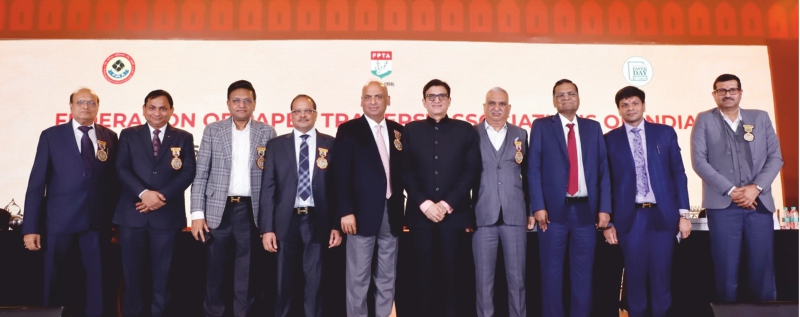
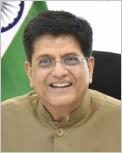
Shri Piyush Goyal, Union Minister of Commerce & Industry, Consumer Affairs, Food & Public Distribution, and Textiles, addressed the 62nd Annual General Meeting of the Federation of Paper Traders Associations in India. He praised the growth of the Indian paper industry and said, “The paper industry will continue to prosper as the country grows economically.” Recognizing the significance of the paper industry, Shri Goyal highlighted its integral role as a carrier of knowledge, history, literature, and an essential medium in everyday life. He noted that in the digital era, the paper continues to hold a prominent position, offering accessibility and serving multifaceted purposes including communication, branding, packaging, and much more.
Sh. Goyal emphasizes the importance of integrated mills, economies of scale, and fostering innovation for competitive quality and service in the paper industry. He said, “We’ll need some more integrated mills. We’ll have to focus on economies of scale so that we can compete with the rest of the world. I think more research or innovation with the latest technology being used for manufacturing paper will help us not only meet high-quality standards or the quality control orders that BIS has put out, but will also help us become a part of global value chains and encourage a greater degree of value addition in India.”
Recalling Prime Minister Modi’s initiative ‘Mission Life’, he said, “ I think one of the critical elements of that was ensuring that we have a decarbonized world and we have sustainable manufacturing practices. Also, we reduce wastage in our consumption pattern. Atma Nirbharta is the way forward. We’ll have to expand our domestic production capacity and the focus should be on getting new grades of paper in the country.”
In his closing remarks, the Minister commended the paper industry representatives as torchbearers of New India’s aspirations and contributors to the nation’s growth story. He reiterated the collective vision to propel India towards becoming a developed nation, underscoring the industry’s pivotal role in this transformative journey.

Mr. Ramesh Garg, President of the Paper Merchant Association, welcomed all the delegates and the dignitaries to the conference and said, “I hope that this event will give a new direction to the business of all the people present here and involved in the paper industry.”

Mr. Vinay Jain, Reception Committee Chairman and MD of MLM India, giving his insights on the challenge that might be faced by the paper industry in the future said, “Today at this 62nd AGM and Conference by FPTA, we are looking to focus on the future, as the businesses might face challenge in the future because of the rapid digitalization and growth of the artificial intelligence. So as FPTA, we have to look further into how our second generation comes into the business and upgrade on these economic changes.”
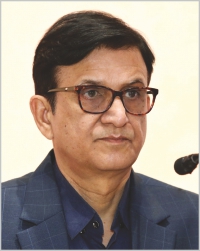
Mr. Aseem Bordai, President, Federation of Paper Traders Association of India, gave the presidential address and praised the rapid economic growth of the country, “India, that is, Bharat, is the fifth largest economy in the world on GDP basis and the third largest economy in the world by GDP PPP basis after China and the US. ”
He further commented on the initiative of the Government of India, the NEP 2020, saying, “The National Education Policy (NEP) 2020, which emphasizes ensuring universal access to school education at all levels shall achieve 100 percent youth and adult literacy and increase public investment in the education sector to reach 6 percent of the country’s GDP. The impact of NEP 2020 on the domestic demand for writing and printing paper is yet to be felt. This delay has been due to the impact of COVID-19. The green shoots will likely be visible from the next school and college session. If you try to reuse, you will reduce. Chances are you will recycle also. The country lacks an organized collection, sorting, and grading system of waste paper. Each time you recycle paper products, you are minimizing the human impact on the environment and it’s helping to reuse valuable resources again and again. Paper recycling is one of the best examples of how we, as a society, work to protect our environment and are part of a circular economy.”
Mr. Bordai highlighted the dependency of the Make in India scheme on the Government of India’s initiative to regulate the domestic producers to comply with few regulations. He added, “ The success of Make in India’s scheme for the paper and paper board sector is dependent on the Government of India’s initiative to regulate the disclosure of percentage-wise raw material usage in the product on the labels so it is visible to the buyer, the present laws and rules be amended so that the paper products are statutorily bound to print the composition of the fiber used in percentages on the label visible to the naked eyes. This will inform the customer of the type of source of fiber in the finished paper and put pressure on the domestic player to shift to domestic fiber. Thereby reducing imports and saving foreign exchange.”
He further added, “ All domestic producers without any exemption should be covered under Extended Producer Responsibility(EPR), making the producers collect, sort, and recycle the waste paper into fiber. The Government of India should bring together all the stakeholders to finalize the standardized nomenclature along with their physical and chemical properties and put an end to the use of prefixes and suffixes. These measures will bring transparency in the system and lend credibility to the Make in India initiative.”
Highlighting the threat of plastic pollution and the need for collective action, Mr. Bordai said, “Plastic pollution is one of the most important environmental problems that we face today. It impacts the environment and our health and well-being. We have all contributed to this problem, mostly unknowingly. And we must work to reduce and ultimately end plastic pollution. Paper can be substituted in all forms of packing products with government support and initiative. And with new research, we need to reduce the use of plastic and bring biodegradable products into use.”
Watch: Starkraft to Offer Capacity of 350,000 tons from May 2024
Additionally, he gave his insight into the changing landscape of the paper industry. He stated, “The Department of Promotion and Industries of Internal Trade (DPIIT), under the Ministry of Commerce and Industry, in its annual report for the financial year 22-23, states that the domestic paper industry remains largely a fragmented sector consisting of small, medium, and large paper mills, with production ranging from 5 metric tons to 2000 metric tons per day. In the financial year 21-22, there were more than 900 paper mills, out of which only 553 mills were operational. With a total operating capacity of around 25.61 million tons, capacity utilization of more than 87 percent, and total consumption of paper load and newsprint stood at 21.14 million tons. The production stood at 22.50 million tons, exhibiting an increase of 3.69 percent on a year-on-year basis. Presently, the share of wood, agricultural residues, and waste paper-based mills stands at 18 percent, 7 percent, and 75 percent respectively. 2.17 million tons of paper, paperboard, and newsprint were imported under ITC Chapter 46 as compared to 2.098 million tons in the previous year, an increase of about 3.4 percent. Exports of 3.53 million tons of paper and paperboard were significantly higher by 36.83 percent compared to the previous year.”
He concluded the speech by talking about the traders. He said, “The traditional path for paper traders is fading, replaced by uncertainty and rapid adjustments. Manufacturers constantly shift strategies, technology disrupts established practices, and expecting continuous advancement is unrealistic. The key takeaway is to prioritize earning power and choice in work, avoiding dependence on predefined paths. FPTA acknowledges the challenges but emphasizes the opportunities emerging from this dynamic environment. By uniting expertise and leadership, the organization aims to benefit members, clients, and communities across the country. They remain committed to safety, security, and supporting member goals while upholding their culture, tradition, and conservative approach. Leadership, for FPTA, is about caring for those entrusted to them. They recognize paper traders’ contributions to society and nation building, believing everyone has the power to shape a better future. National Paper Day celebrations, initiated by FPTA, aim to educate people about responsible paper use, debunking myths and greenwashing. They highlight paper’s 2,000-year history and its natural, reusable, recyclable, and biodegradable qualities. FPTA encourages responsible paper use while challenging the myth that reducing paper saves trees.”

Talking about the Indian paper industry, Mr. Akshay Jain, Managing Director, Silverton Pulp & Papers, said, “The Indian paper industry is very vast. The paper industry starts with the farmers who are the foundation of the country’s progress and ends with the consumers across the globe. So our industry is an industry connected with every society and class of our country and is making huge efforts to make the country famous in the world. Many people are connected directly and indirectly as well. Our industry knowingly, or unknowingly gives employment to at least 1000 people and runs a family of at least 10,000 people. So it is an industry that wants the best for everyone.”
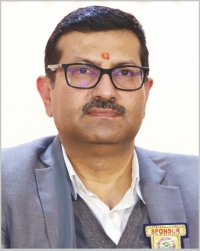
Mr. Sunesh Yadav, Sr. GM-Sales, Century Pulp & Paper, talked about the current scenario of imports in the Indian paper market. He talked about people choosing imports over Indian-made products. He said, “We need to understand why the customer is looking for substitute imports when they have enough capacity available in India. One of the reasons is quality. We are fighting against China and Europeans who have world-class converters manufacturing world-class products. The second thing is cost. We have to continuously work on the cost. Indian paper mills are investing a lot of money in upgrading their machinery or modifying their equipment. It is just because you have to compete against cost without compromising on quality. The third thing is innovation. We need to develop, we need to see the opportunities where we can supply, where we can give you innovative product.”
Mr. Yadav asserted the fact that there is a huge growth potential and opportunity in many segments that are not manufactured in India and are imported. He concluded his speech by talking about the collaborative efforts of the mills, traders, and government so that we could motivate the customers to keep buying paper, to keep using paper, and to keep selling paper.
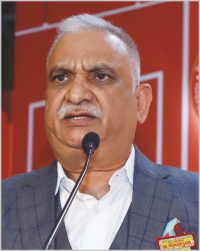
Mr. Prakash Garg, Managing Director of NPT Papers Private Limited, talked about the importance of FPTA’s AGM & conferences as it is a platform where traders can openly discuss their problems with the mill owners regarding the price fluctuations that the traders have been facing for a long time.
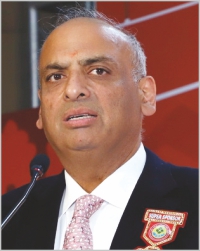
Mr. Yogesh Agarwal, Business Head of BILT Graphic Paper Product Limited, who was also the chief guest at the conference, said, “Market going up or down is a function of triggers. An activity happening in one place causes effects in a distant place, sometimes after six months or maybe after years. It is called the butterfly effect. For example, the recent Red Sea movement caused obstruction there and worked as a trigger for supply chain disruption.”
Mr. Agarwal went on to say, “ Looking at the past 15 years, the paper industry witnessed its first global financial crisis in 2008, when prices slashed from USD 950 to USD 600 in 2009, around a 40 percent fall in three months. It was one of the steepest falls witnessed by the industry. The prices went up again after the global economic recovery. After six months, an earthquake struck Japan, leading to restricted supplies. Again the market went up and was then hit by the European debt crisis. Such triggers can seriously impact the market by causing either increase or decrease of around 30-40 percent.”
He explained that price fluctuations in the market happen due to various factors. He said, “There are two types of variables – organic and inorganic. Organic variables are GDP growth, rising income levels, growing per capita expenditure, and a widening spread of education, which are slow and don’t change much. Inorganic variables include an increase in shipping costs, the effect of the Covid-19 pandemic, the recent Red Sea disruption etc. Organic changes are linear and inorganic are stair-steps. We have to look for inorganic variables which impact the market. We should keep in mind the reach of a market, raw material availability, inventory levels in the supply chain, and cross-currency chess board. If the currency of Brazil or any other pulp exporting country is depreciated, then it will impact the market in Bangladesh and India significantly. In the countries producing coal like Indonesia and Australia, if there is a change in their currency, then it will affect the pulp and paper industry.”
He urged the industry to adopt its distribution strategy according to the changing scenario of the market. Emphasizing the importance of regulations he said, “Regulatory is a very important factor. They impact the market, prices, and so on. Sustainability certifications like PEFC, and BIS, and growth in other industries like e-commerce, and print-on-demand, all these things impact the market. We have witnessed the impact of shipping industries on paper prices. Local seasonal transport, equity performance, natural calamities, technological disruption on demand, and global mergers and acquisitions also impact the paper industry.”
He gave an example of the market scenario in 2021-2022, where the prices had boomed drastically. He stated, “ In 2021-22 the prices went above USD 1000. Although prices had gone above USD 1000 earlier also but in 2021-22 the price stayed above USD 1000 for about 6 months. That is something that has never happened before. If you see the paper cycle it went up and came down within 15 days to 1 month but in 21-22, we saw that prices were above 1000 dollars for 6-9 months.”
Also Read: Paper Industry: Growth & Sustainability Through Green Technologies
Commenting on the fluctuations in prices, he said, “One of the most important things to remember is the wood supply in India. In 2013, the maximum price of the wood was Rs. 13,000. But if we see the present scenario, companies like Century and some other companies have imported wood at last Rs. 25,000 per tonne. The minimum variable cost of the pulp is USD 500. This will make the total cost of the paper to be around USD 700 to 950.
Additionally, we need 20 percent EBITDA to justify our investments in that. So according to that, the minimum cost would be USD 875 and if we talk about high-trade and marginal costing, it would be approximately USD 1200. In India, we have many small mills which are inefficient as compared to big mills in the global market. Earlier, prices of wood and other raw materials were cheaper, Indian mills had an advantage of wood but a disadvantage of size. But today, since the prices have increased globally, Indian mills have the disadvantage of both size and wood. The price of wood has never increased so drastically before.”Urging the companies not to be scared of the price fluctuations, he concluded his speech by saying, “Let me tell you markets are fair to everyone. We need to figure out how to service the market, how to make a combination of business, that we benefit from it and we can do good service. The market is a reality, it’s the same for everyone. We have to be an athlete of sales. As soon as there is a fluctuation in the market, need not to be afraid. We should be confident about whether we are physically fit to handle the fluctuations. Study your model. If the market falls, it’s good. The weaker players will move away from the market. If the market is always running fast, then everyone will keep running.”



